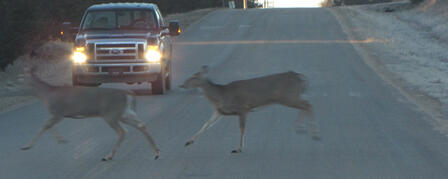MOTORISTS BEWARE: DEER ON THE MOVE IN NOVEMBER

Oct. 27, 2011
Kansas deer-vehicle collisions peak in November
TOPEKA — Deer can be spotted near Kansas roadways any time of year, but motorists should be especially vigilant in the fall. Deer breeding season, called the “rut,” peaks in mid-November, and this is when deer-vehicle collisions are most likely. That’s why the Kansas Department of Transportation (KDOT), the Kansas Highway Patrol (KHP) and the Kansas Department of Wildlife, Parks and Tourism (KDWPT) are working together to raise awareness and help drivers avoid collisions with deer.
According to KDWPT biologist Lloyd Fox, the increase in deer-vehicle crashes at this time of year is strongly influenced by the rut. During rut, deer travel more than in other seasons and pay less attention to hazards such as vehicles. Also during the fall, many deer move to new locations as crops are harvested and leaves fall from trees and shrubs, limiting cover.
Not only are deer more active during the fall, shorter days mean dusk and dawn — when deer are more likely to be on the move — occur when commuter traffic is busiest. According to KDOT spokesperson Steve Swartz, there were 9,109 deer-vehicle collisions reported to KDOT in 2010. Deer-vehicle collisions occur in every Kansas county. In most cases, counties with high human populations and high traffic volumes record the most deer-vehicle crashes. Sedgwick County reported the most crashes with 391, followed by Johnson County with 346 and Butler County with 287.
Motorists should observe the following tips to avoid deer collisions:
- be especially watchful at dawn and dusk when deer are particularly active;
- watch for more than one deer — if one crosses the road, others may follow;
- reduce speed and be alert near wooded areas or green spaces such as parks or golf courses and near water sources such as streams or ponds;
- don’t swerve to avoid hitting a deer — the most serious accidents occur when motorists swerve and collide with another vehicle or run off the road and hit an obstacle;
- heed deer crossing signs;
- always wear a seat belt; and
- use bright lights and slow down whenever the reflective eyes of deer are spotted.
According to Technical Trooper Josh Kellerman of KHP, if you hit a deer, pull onto the shoulder, turn on your emergency flashers, and watch for traffic before exiting your vehicle. Do not try to remove a deer from the roadway unless you are certain it is dead; an injured deer is dangerous. If you have a cellular phone and are on a Kansas highway, dial *47 (*HP) for a highway patrol dispatcher or *582 (*KTA) for assistance on the Kansas Turnpike, or dial 911 from anywhere.
Anyone involved in a deer-vehicle crash that results in personal injury or property damage that totals $1,000 or more is required to immediately report the crash to the nearest law enforcement agency. Failure to report any traffic accident is a misdemeanor and may result in suspension of driving privileges.
If you are involved in a non-injury crash on an interstate or U.S. highway, or any divided or multi-lane road in the state of Kansas, and if you are not transporting hazardous materials, you are required by law to move your vehicle out of the lane of traffic. This law is intended to help keep drivers and passengers safe by getting them out of the lane of traffic, and away from oncoming vehicles. Make sure you and your passengers are buckled up and are using the appropriate child safety seats, practices which help prevent injuries or death should you be involved in a crash.
For more information, phone Swartz (KDOT) at 785-296-3585 or email stevesw@ksdot.org; Kellerman (KHP) at 785-296-6800; or Ron Kaufman (KDWPT) at 785-296-2870 or email ron.kaufman@ksoutdoors.com.
-30-









